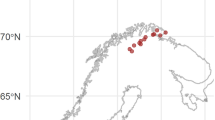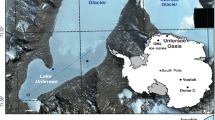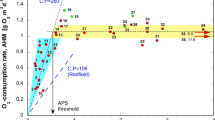Abstract
The dry valleys of southern Victoria Land in Antarctica contain several closed basins in which perennially ice-covered lakes are found. One of the most unusual features of these lakes is the occurrence of high O2 concentrations in the water column; values ranging from slightly more than saturation to more than four times saturation have been reported1–3. Recently, we considered a bulk O2 budget for Lake Hoare, Antarctica, which led us to suggest that biological processes alone were not sufficient to explain the observed elevated oxygen levels3. Consequently, there must be a non-biological source of O2. We suggested that this source results from the exclusion of O2 during the freezing of aerated meltstream water at the bottom of the ice cover, and predicted that this physical mechanism should also enhance the other atmospheric gases. Here we report the results of a study which, for the first time, documents the supersaturation of N2 in a lake. Dissolved N2 levels of 145% and 163% were determined from samples taken just below the ice cover and at a depth of 12 m, respectively. The relative importance of biological and abiological sources is reflected in the ratio of N2 concentration to O2 concentration. In Lake Hoare this ratio was 1.20 at the ice/water interface and 1.05 at 12 m; considerably different from the ratio in equilibrium with air (∼1.8). Based on these results, we have determined that about half of the net O2production in the lake is the result of biological processes.
This is a preview of subscription content, access via your institution
Access options
Subscribe to this journal
Receive 51 print issues and online access
$199.00 per year
only $3.90 per issue
Buy this article
- Purchase on Springer Link
- Instant access to full article PDF
Prices may be subject to local taxes which are calculated during checkout
Similar content being viewed by others
References
Parker, B. C., Simmons, G. M. Jr, Love, F. G., Wharton, R. A. Jr, & Seaburg, K. G. Biosdence 31, 656–661 (1981).
Parker, B. C., Simmons, G. M. Jr, Seaburg, K. G., Cathey, D. D. & Allnutt, F. C. J. Plank. Res. 4, 271–286 (1982).
Wharton, R. A., McKay, C. P., Simmons, G. M. Jr, & Parker, B. C. Limnol. Oceanogr. 31, 437–443 (1986).
Palmisano, A. C. & Simmons, G. M. Jr Polar Biol. (in the press).
Bari, S. A. & Hallett, J. J. Glaciol. 13, 489–520 (1974).
Top, Z., Martin, S. & Becker, P. Geophys. Res. Lett. 12, 821–823 (1985).
Allnutt, F. C., Parker, B. C., Seaburg, K. G. & Simmons, G. M. Jr, Hydrobiol. Bull. 15, 99–109 (1981).
Gardner, T. J., Green, W. J., Angle, M. P. & Vamer, L. C. Antarct. J.U.S. 18, 178–180 (1984).
Weiss, R. F. Deep-Sea Res. 17, 721–735 (1970).
Wharton, R. A., Parker, B. C. & Simmons, G. M. Jr, Phycologia 22, 355–365 (1983).
Welch, H. E. Limnol. Oceanogr. 19, 65–73 (1974).
Adams, W. P. Musk-ox J. 18, 86–98 (1976).
McKay, C. P., Clow, G. D., Wharton, R. A. Jr, & Squyres, S. W. Nature 313, 561–562 (1985).
Nedell, S. S., Squyres, S. W. & Andersen, D. W. Icarus (in the press).
Author information
Authors and Affiliations
Rights and permissions
About this article
Cite this article
Wharton Jr, R., McKay, C., Mancinelli, R. et al. Perennial N2 supersaturation in an Antarctic lake. Nature 325, 343–345 (1987). https://doi.org/10.1038/325343a0
Received:
Accepted:
Issue Date:
DOI: https://doi.org/10.1038/325343a0
This article is cited by
-
Response of Sandy Lake in Schirmacher Oasis, East Antarctica to the glacial-interglacial climate shift
Journal of Paleolimnology (2017)
-
Stable Carbon and Nitrogen Isotopic
Aquatic Geochemistry (2004)
-
Paleolimnology of the McMurdo Dry Valleys, Antarctica
Journal of Paleolimnology (1994)
-
The geochemistry of methane in Lake Fryxell, an amictic, permanently ice-covered, antarctic lake
Biogeochemistry (1993)
-
Perennially ice-covered Lake Hoare, Antarctica: physical environment, biology and sedimentation
Hydrobiologia (1989)
Comments
By submitting a comment you agree to abide by our Terms and Community Guidelines. If you find something abusive or that does not comply with our terms or guidelines please flag it as inappropriate.



